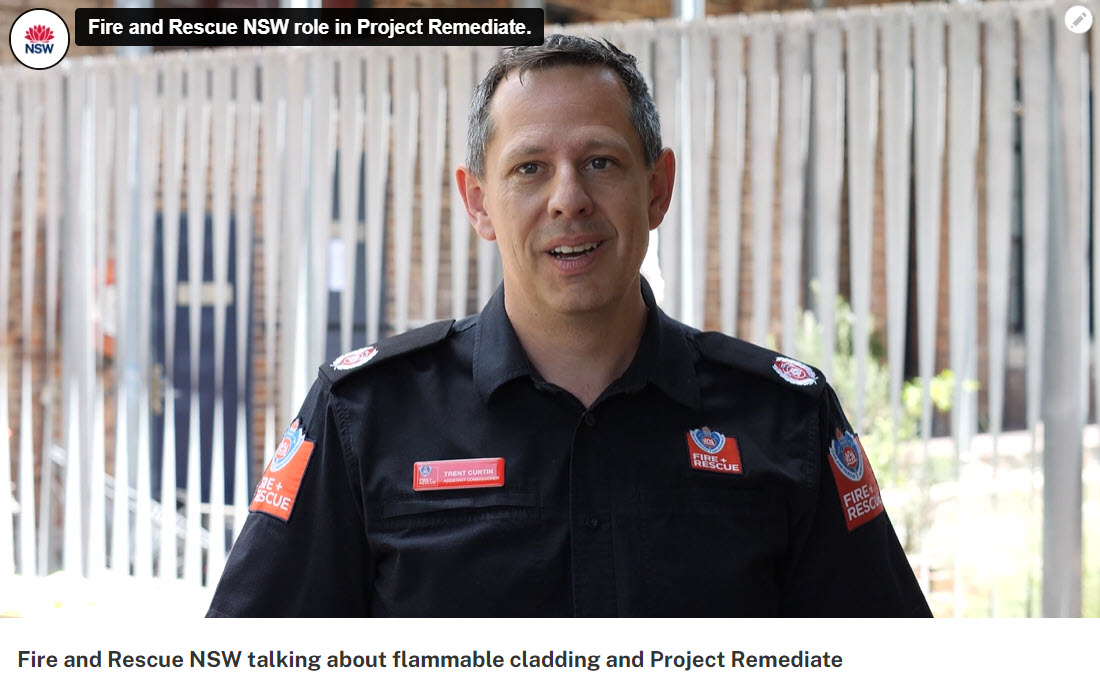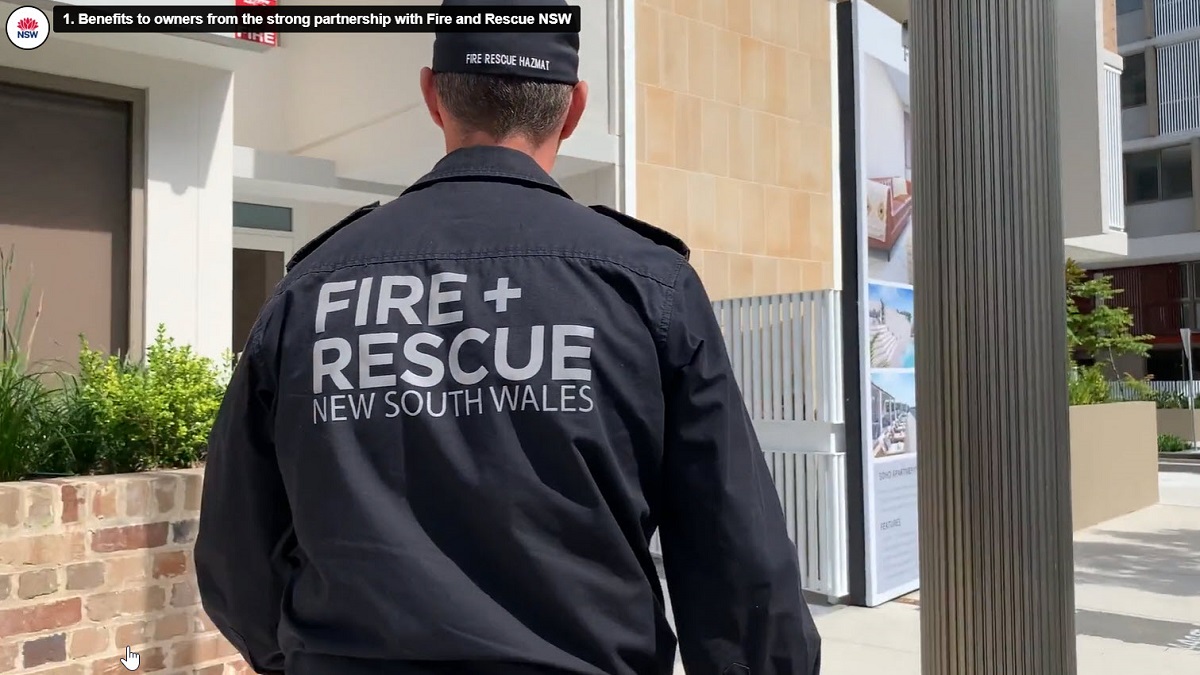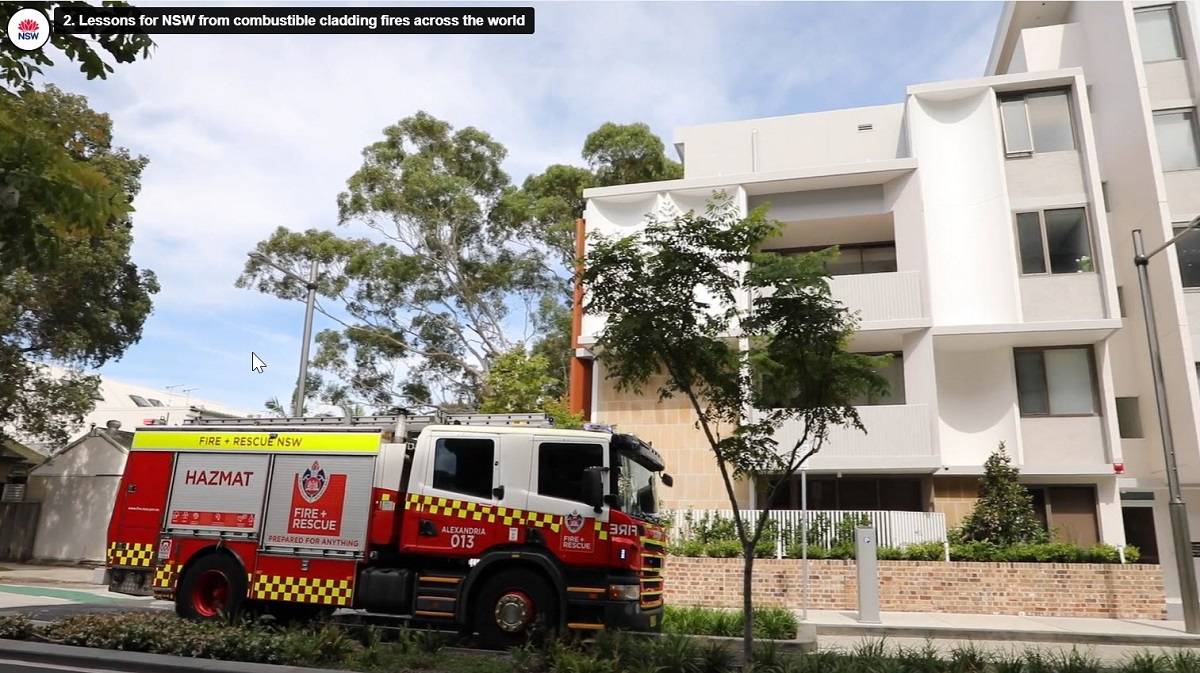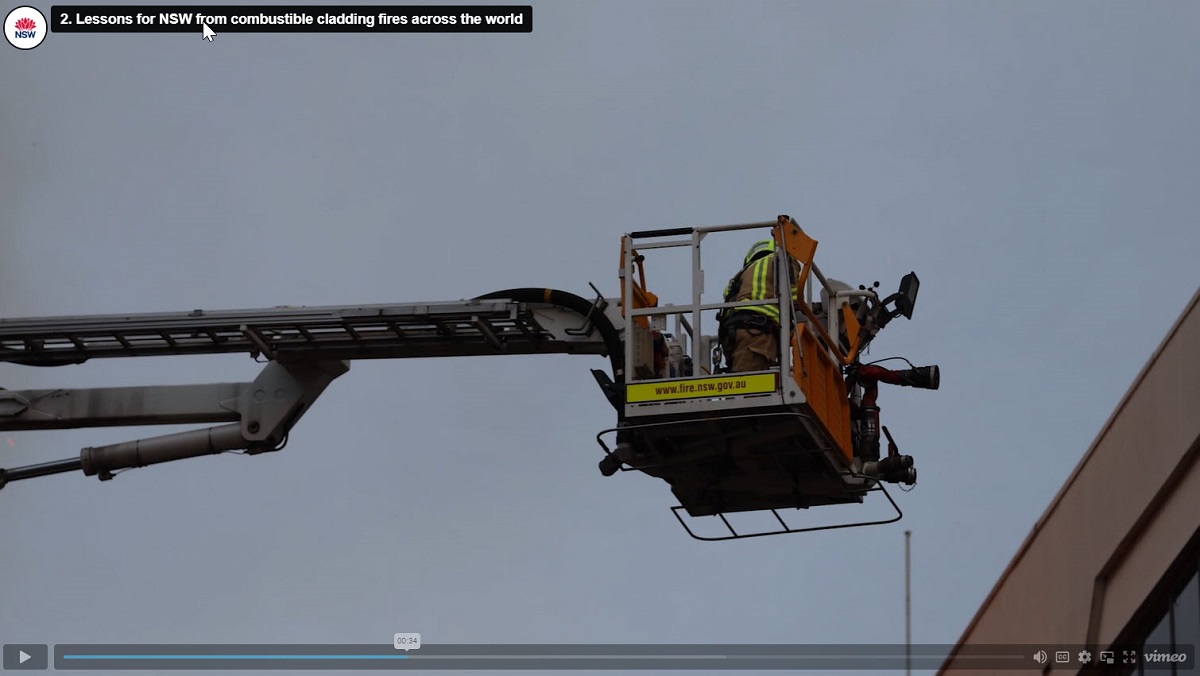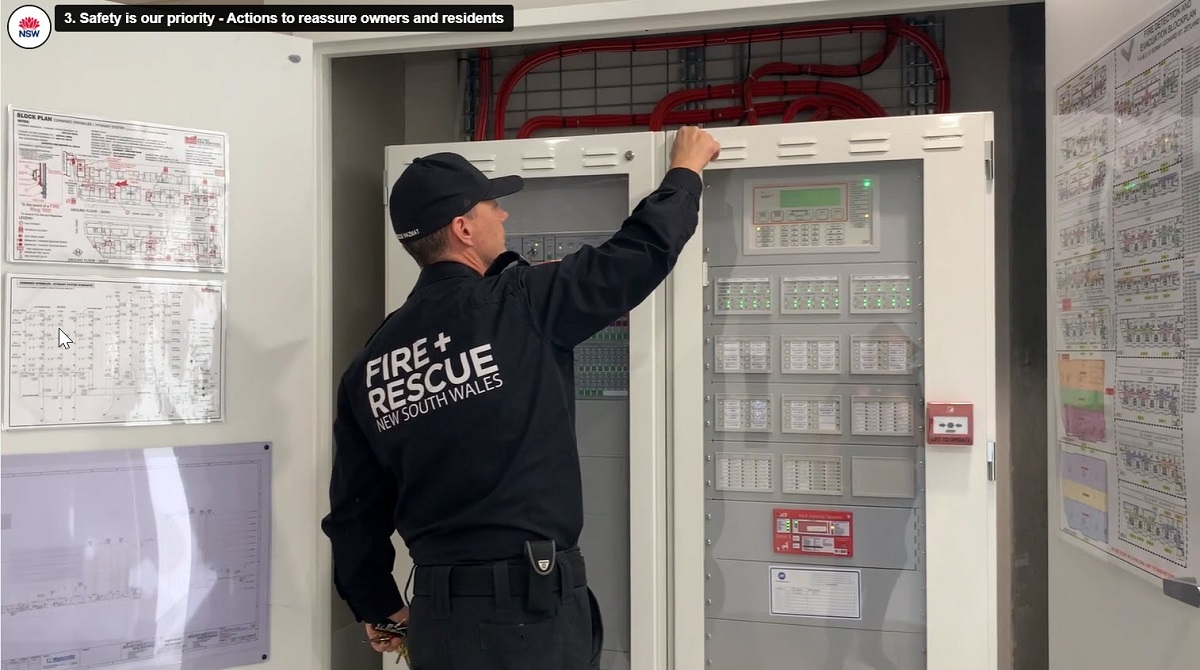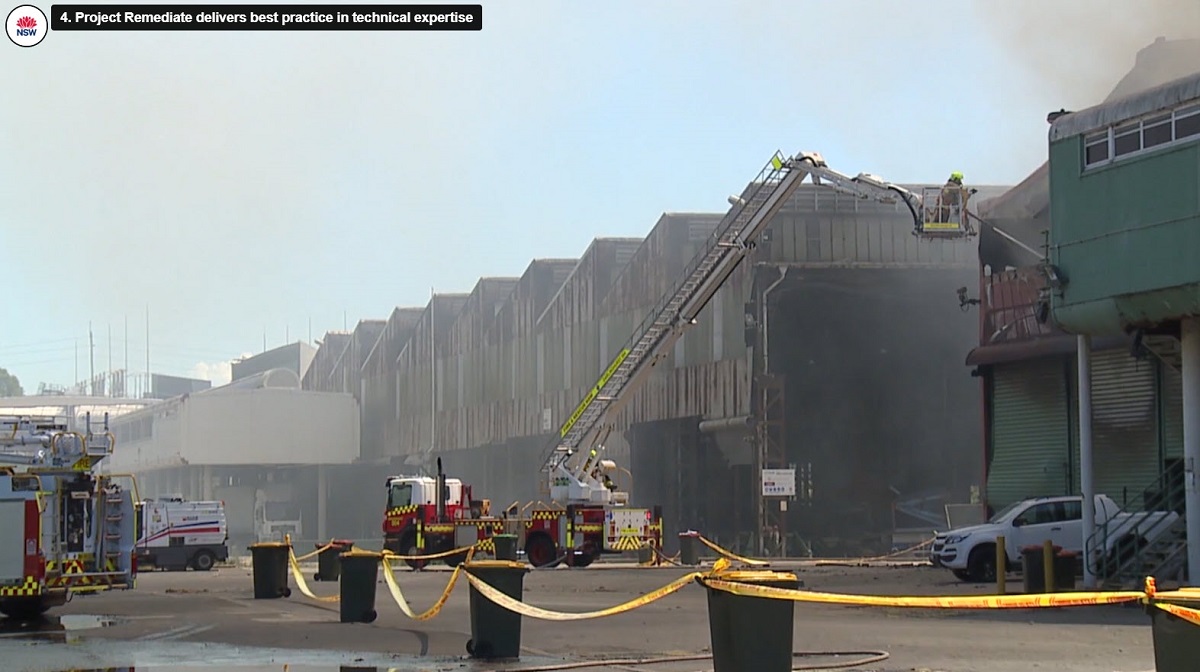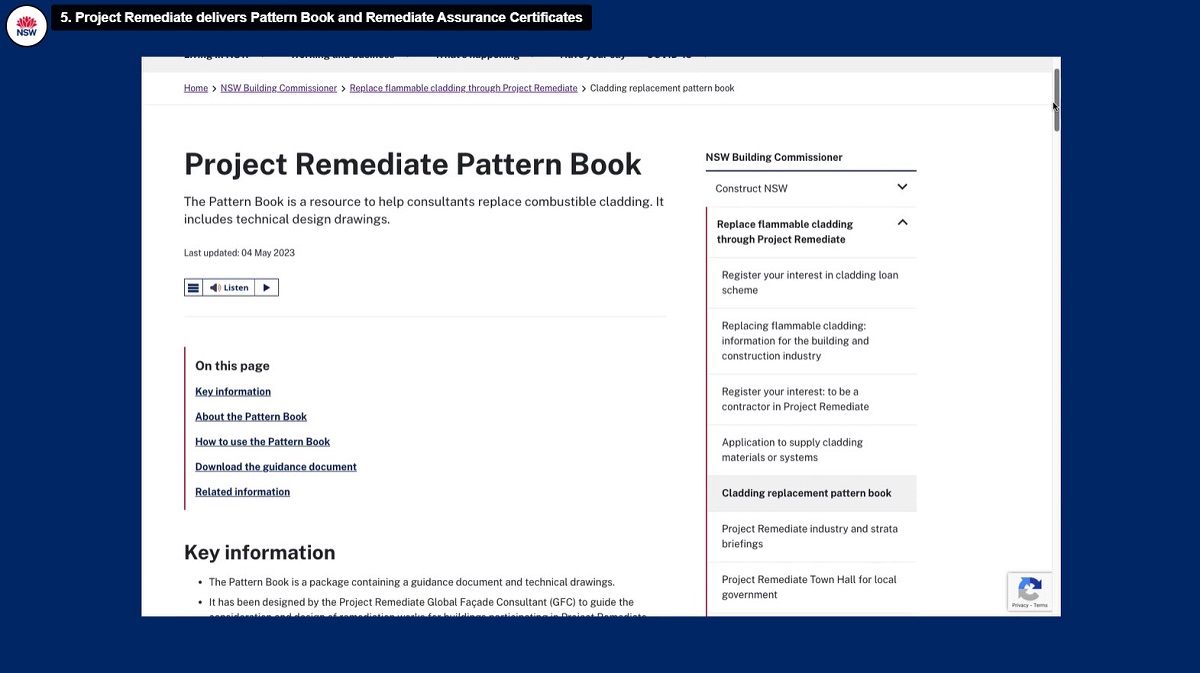Replace flammable cladding through Project Remediate
Project Remediate is a voluntary (opt-in) program to replace flammable cladding for eligible class 2 residential apartment buildings and will continue as a key part of our new Building Commission NSW.
Key information
- Project Remediate is a voluntary (opt-in) program to replace flammable cladding for eligible class 2 residential apartment buildings.
- It offers a 10-year interest-free loan and assistance from experts.
- Financial support is available for eligible building owners.
- You will end up with a replacement cladding that is certified, safe, long-lasting and insurable.

Message from the Commissioner
Latest update April 2023
Government support to fix flammable cladding
The NSW Government is offering support to eligible owners corporations to remediate (fix) flammable cladding on residential apartment buildings.
Project Remediate is a program to help remove combustible cladding on an estimated 225 buildings.
It offers:
- 10-year interest-free loans to fund the remediation work
- quality assurance and program management services delivered by experienced professionals.
It is a voluntary (opt-in) program, that only fixes flammable cladding.

How the government is addressing the problem of combustible cladding on apartment buildings in New South Wales.
Eligibility
To apply for a Project Remediate interest-free loan, your building must be:
- a residential apartment building (Class 2) in NSW. This includes multi-use buildings, for example part commercial/part residential
- confirmed by the Cladding Taskforce to have a high-risk combustible cladding façade that requires remediation.
What happens when you register?
Registrations for Project Remediate have now closed.
If you have any enquiries please contact the Office of Project Remediate by emailing projectremediate@customerservice.nsw.gov.au.
The Managing Contractor will review your documents and arrange a time to inspect the cladding on your building.
- A design team will work with your owners corporation and local council (or other authority) to prepare two remediation designs.
- The design chosen will be fully documented, quotes for the remediation work will be prepared, and you will be offered a fully priced remediation contract.
- A Lannock Strata Finance relationship manager will present the loan agreement and explain the loan and repayments, terms and conditions, and how the funds are administered.
- The interest-free loan contract and loan payments will be administered by Lannock Strata Finance.
- If your owners corporation decides to continue, you will be asked to approve the remediation design and be presented with contracts for the interest-free loan, program management, remediation designs and other services involved in the work.
- We will ensure that you have all the necessary information and documentation required so that your owners corporation can make decisions.
- The Owners Corporation decides if they want to proceed with the agreed design and join the program, or exit at no cost.
- The Owners Corporation is required to table the Project Remediate loan contract at a general meeting and pass the relevant motions to resolve to borrow.
- The Owners Corporation returns the loan and construction contracts.
- Lannock Strata Finance will review your loan contract and relevant documentation and provide a response within two business days on the status of your loan approval.
Owners corporation sign contracts.
Once contracts are signed, the Project Remediate Managing Contractor will schedule the building works.
- Work will begin to replace cladding.
- Residents will be kept updated about the work at all times and will have access to the building and amenities as much as possible.
- The Managing Contractor will respond and act quickly to fix any issues that may arise.
- The building work may take around 180 days (6 months) to complete, depending on the size of the job.
- Once work is complete, a Remediation Assurance Certificate will be provided to the owners corporation. A defects liability period of 6 months will apply.
- Your Owners Corporation will make monthly repayments to repay the interest-free loan via direct debit on the Owners Corporation’s bank account. GST does not apply to the loan repayments.
- The Owners Corporation will levy owners for repayments - although the Owners Corporation can choose the levy cycle, most Owners Corporations issue quarterly levy invoices.
- A Lannock dedicated loan relationship manager will be assigned to you for the lifecycle of the loan. They will be on hand every step of the way to provide advice, support and arrange the servicing and management of the loan.
How does it work?
The remediation work will be undertaken in these phases:
- Triage phase
- Design phase 0% - 30%
- Design phase 30%-100%
- Construction phase
This information may be adjusted as buildings enter or leave the program.

Project Remediate - Cladding Replacement Pattern Book
This short video outlines the importance and value of Project Remediate's collaborative and innovative approach to remediating cladding in residential apartment buildings...Read more
97 owners corporations across 34 local government areas have opted in and are voluntarily and actively participating in the Project Remediate. Of these:
- Two have been fast-tracked and remediation work is complete
- 12 are under construction
- 15 have signed contracts to commence and pre-construction is underway
- 51 are in the final design and tender phase
- 11 are in the early design stage
- 8 are undergoing onsite investigation or desktop review
- 155 are inactive or their participation is ‘on hold’ as they consider other options for remediation. This includes pursuing the original builder or developer in litigation or arranging independent remediation within the oversight of the consent authority.
- 21.54 tonnes of flammable cladding has been recycled, with an overall recycling rate of 99.97% to date.
Construction or the tendering process has commenced on the majority of these buildings in 2023, with ongoing activities continuing into 2024.
Who is doing the work?
Project Remediate uses expertise from across industry, academia, and, government. The Managing Contractor and Global Facade Consultant have a lead role in replacing potentially combustible cladding on buildings. They are guided by the Cladding Product Safety Panel and are supported by a number of other agencies.
Watch the NSW Building Commissioner introduce the Managing Contractor and global façade consultant.

The NSW Building Commissioner introduces the Managing Contractor and Global Façade Consultant.
The Managing Contractor
Hansen Yuncken is the Project Remediate Managing Contractor. As the Managing Contractor, they work with owners corporations and guide them through the remediation process from start to finish, and coordinate all the activities necessary to deliver a safe and durable solution for each building.
The Managing Contractor engages reputable and experienced contractors to perform the remediation work and other services and makes sure that remediation work meets Project Remediate requirements. They also ensure contractors have adequately scoped the work and are able to complete it to Project Remediate standards.
If your owners' corporation has already engaged a builder, they can register their interest for Project Remediate by emailing Hansen Yuncken.
They need to meet the requirements for pre-qualification to participate.
These are the other agencies or officers involved in ensuring combustible cladding is replaced to a high standard.

Meet the team from Project Remediate that will guide you through the whole remediation journey.
ACOR Consultants has been appointed as the Global Facade Consultant (GFC) for Project Remediate.
They developed and maintain a Project Remediate Pattern book used to design a remediation solution for each building.
They work in close consultation with the Cladding Product Safety Panel (CPSP) to inform the selection of remediation products and systems to deliver a safe and insurable result.
Building investigators assess, inspect and report on the condition of the existing cladding and external wall build-up, including testing.
Designers, architects, BCA consultants and quantity surveyors create and document remediation plans for each building, following guidance from the Global Facade Consultant.
Remediation contractors carry out remediation work including coordinating any trade contractors using tendered building contracts.
Superintendents oversee building works, verify that work is completed in accordance with the contract, designs and plans and provide advice on progress payment claims and practical completion.
The assurance consultants provide compliance assurance and certify that remediation work has been carried out in accordance with any Fire Safety Orders or conditions of approval.
Retrospective financial assistance
Owners corporations who began cladding remediation work before Project Remediate was available may be eligible for retrospective financial assistance.
What if individual owners can't make the extra levy repayments?
- Residential owner occupiers who have difficulty in making their levy payments for their portion of the loan under Project Remediate can apply for hardship relief. Read our hardship policy.
- Lannock Strata Finance will review applications for hardship relief.
- If it is approved, a hardship certificate will be issued to the owner within 14 business days of receiving an application with all required documentation, and monthly loan repayments from the Owners Corporation will be adjusted accordingly.
- The Owners Corporation will be provided with the Project Remediate Hardship Policy after your Loan presentation session.
Insurance
Project Remediate has arranged public liability, professional indemnity and contract works insurance for all contractors and consultants who do work and provide services under this program.
The public liability insurance with Lloyds consists of two policies: the first policy has a claim limit of $20 million and the second policy provides an additional claim limit of $30 million. Together, the two policies provide an overall claim limit of $50 million. It covers contractors and consultants for public liability for the works performed and the services provided.
File
A ($20m) public liability insurance policy under Project Remediate (PDF 499.86KB)File
A second ($30m) public liability insurance policy for Project Remediate (PDF 172.93KB)Professional indemnity insurance is provided by Pacific Indemnity Underwriting Solutions Pty Ltd on behalf of Berkley Insurance Company. It covers consultants (for example, designers, superintendents and assurers) for the professional services they provide. It has a limit of $10 million for a claim/building and $100 million in total for all claims/buildings.
File
A professional indemnity insurance policy as part of Project Remediate (PDF 661.54KB)Insurance for contract works (material damage) is provided by QBE Insurance (Australia) Limited. It covers contractors for physical loss or damage to the works they provide or perform. It has a limit of the value of the works at your building up to $10 million for a claim.
File
An insurance policy for contract works (material damage) under Project Remediate (PDF 524.16KB)Insurance for buildings with combustible cladding FAQs
Helping owners corporations with combustible cladding navigate insurance.
The NSW Government has been working on measures to address the fire safety risks associated with unsafe cladding since January 2015.
The NSW Cladding Taskforce has coordinated the NSW Government’s response to addressing fire safety risks arising from the use of aluminium cladding on buildings in NSW.
Certain class 2 residential buildings have been confirmed by the Cladding Taskforce to have a high-risk combustible cladding (Aluminium Composite Panel (ACP)) façade that requires remediation.
Aluminium Composite Panels (ACP) are a type of cladding material that consists of two thin aluminum sheets bonded to a core material, often made of polyethylene. In recent years, there have been instances where buildings with ACP cladding have experienced rapid fire spread, posing significant risks to occupants and property.
The Building Code of Australia has deemed that ACP cannot be used in class 2 residential buildings without specific concessions or performance solutions. Furthermore, in August 2018 the NSW Fair Trading Commissioner issued a product ban specifically prohibiting the use of certain ACP with a PE core in residential buildings.
These safety measures are intended to mitigate the risks associated with combustible cladding and ensure the safety of occupants.
Owners corporations remediating privately need to ensure that the risk from combustible cladding has been removed. Importantly, all cladding remediation works undertaken pursuant to a Fire Safety Order need to be completed to the satisfaction of the consent authority (Council or the Department of Planning and Environment).
Yes.
All cladding remediation works undertaken pursuant to a Fire Safety Order need to be completed to the satisfaction of the consent authority (Council or the Department of Planning and Environment). In addition, works completed under Project Remediate will receive a Remediation Assurance Certificate.
The Remediation Assurance Certificate is a great benefit for insurers as it publicly demonstrates that the risk from combustible cladding has been removed and that the work has been delivered to Project Remediate standards and in line with the requirements of the Cladding Product Safety Panel (CPSP).
In providing insurance cover for a building, insurers set premiums according to an assessment of the residual risk of damage occurring and a claim being made against the policy. A key component of this assessment is consideration of effective risk mitigation measures which have been put in place. Once owners corporations have completed remediation, the insurance policies, premiums, terms, and conditions can be reassessed to factor in the mitigated risks. Owners Corporations are encouraged to contact their insurer to understand these benefits.
At completion, the Remediation Assurance Certificate is provided to owners corporations by Project Remediate.
Design and building practitioners must comply with the Design and Building Practitioners Act 2020 (DBP) when designing and undertaking any cladding remediation works on a class 2 building.
Watch David Chandler, NSW Building Commissioner speak on the importance of remediation work complying with the Act here.
Any work that doesn’t comply with the Act will be deemed non-compliant. This may have adverse insurance consequences such as non-insurability of non-compliant work.
Insurance companies do consider the quality of workmanship on buildings, and an Independent Construction Industry Rating Tool (iCIRT) rating is an indicator of quality.
The iCIRT rating is from a private company, Equifax, and helps customers identify developers and builders who have a proven track record of quality and integrity, supported by objective evidence of their past capability. The iCIRT rating increases transparency for both developers and customers and reassures owners.
Yes, if owners corporations are struggling to secure or update an insurance premium in relation to combustible cladding and the building is progressing in Project Remediate, Hansen Yuncken can provide a letter for the relevant insurance company that explains progress in the program to date which may assist with premium extensions.
How to make an insurance claim
Insurance policies have been arranged by the following brokers to report an incident or loss or to request a claim:
- Lockton Australia can be contacted by emailing Lockton Australia in relation to:
- Professional indemnity insurance
- Construction risks (material damage)
- Insurance House can be contacted by emailing Insurance House in relation to:
- Public liability insurance
As a general guide:
- Report the incident or loss to Lockton Australia or Insurance House as soon as possible, and tell them what insurance policy you are reporting under.
- Do not admit liability to anyone at any time, even if you think you are at fault.
- Immediately do whatever is necessary to prevent further loss.
- Document as much as possible.
- Complete and email a claim form to Lockton Australia or Insurance House as soon as possible.
Home Building Compensation Fund (HBCF) insurance under Project Remediate
The Home Building Compensation Fund (HBCF) insurance covers the situation where a builder becomes insolvent. Normally, the builder takes out this insurance, the cost of the insurance is built into the building contract price and an owners corporation can make a claim under the policy.
As Project Remediate provides high-quality assurance and strong insurance coverage to owners corporations that join the program, special arrangements have been negotiated with the State Insurance Regulatory Authority (SIRA) that are unique to remediating combustible cladding under Project Remediate.
These arrangements allow an owners corporation to seek an exemption from paying for HBCF insurance.
If an owners corporation joins Project Remediate, they have the option to be exempt from HBCF insurance, thereby lowering the contract price. The owners corporation should seek independent legal and other advice before choosing this option.
Home Building Compensation Fund (HBCF) FAQs
The Home Building Compensation Fund (HBCF) provides a safety net for home owners in NSW faced with incomplete and defective building work carried out by a builder or tradesperson. It is managed by icare.
Licensed contractors that take on residential work over $20,000 need insurance cover through HBCF. They must obtain this cover before starting any work or taking any money under the contract, including the deposit.
The Project Remediate Managing Contractor, Hansen Yuncken will provide a consent document form to the owners corporation at the same time as providing the remediation contracts. The consent document form is uniquely tailored to Project Remediate because of the quality assurance that the program offers.
If the owners corporation decides at a general meeting to sign Project Remediate contracts, it will be given the option to consent to the contractor applying to SIRA for an exemption from HBCF insurance. If the owners corporation chooses this option, the corporation will need to acknowledge it has had the opportunity to obtain independent legal and other advice about the exemption before making this choice.
SIRA will make a decision whether or not to grant an exemption upon receipt of documents and information provided. They will consider:
- The information provided about the owners corporation, the building, and the contractor
- Confirmation from the Office of Project Remediate that the owners corporation is eligible to participate in Project Remediate.
The exemption is not available for works done outside Project Remediate.
Contact your Hansen Yuncken Project Manager if you need more information about HBCF insurance or the exemption.
Yes. Owners corporations who are part of Project Remediate are able to obtain an exemption from HBCF insurance due to the quality assurance and insurances provided through Project Remediate.
If you undertake private remediation, exemptions do not apply (see below).
If you undertake remediation of your building’s combustible cladding outside of Project Remediate, your builder must obtain HBCF insurance prior to commencing work.
Under the Home Building Act 1989, and Home Building Regulation 2014, remediation is classified as repair under sub clause 2(1)(c).
While the Home Building regulation clause 56(1) does provide an HBCF exemption for construction of Residential flat buildings, this exemption does not apply to repair works.
If you are remediating combustible cladding privately, ensure your owners corporation don’t get caught short!
Financial support
Financial payment to cover strata management costs
Owners corporations are eligible for a payment of between $5,000 and $15,000 to help with strata management costs of participating in Project Remediate.
Financial support for local councils
Councils can access payment for the administration needed for buildings that join Project Remediate.
Retrospective assistance for remediation work
Owners corporations who began cladding remediation work before Project Remediate was available may be eligible for financial assistance.
What happens if additional remedial work is identified as part of our review of your building?
Sometimes, when we investigate cladding remediation we identify other issues with a building that can be fixed at the same time. When you consider that erecting scaffolding is often the most expensive line item in remedial works, it may make sense to address a number of problems at the same time.
Where an owners corporation needs a loan to fund additional works to non-façade building elements that are outside of the scope of Project Remediate, there are a range of speciality strata lenders. When looking for finance, it’s important to find a financial institution and a loan which is right for you.
Please find below a list of lenders that we are aware of who specialise in lending to strata bodies:
Lannock are the leading strata specialist in Australia, helping owners protect and improve their properties with efficient finance. Lannock can help fund improvement projects like renovations, defects, green projects and repairs. Lannock will also fund strata insurance, professional services and litigation.
Macquarie Bank has specialised in providing financial services to strata managers and their clients for over 30 years. Offering simple payments, bundle multiple repairs, upfront funding and no personal guarantee.
Austrata was established in 2020 to meet a rapidly growing demand for strata finance in Australia. They provide strata schemes with easy access to strata loans and offer a simple application process, competitive interest rates and a friendly team to guide customers each step of the way.
StrataLoans is a product of StrataCash Management, which was established over nine years ago. StrataCash has opened accounts for over 10,000 owners corporations and bodies corporate across Australia.
Plenti Group was established in 2014 with their loan originations growing consistently, supported by diversified loan products, distributions channels and funding, and is underpinned by their exceptional credit performance and continual innovation.
Hardship provision for other loans
Hardship provisions for lenders outside of Project Remediate are determined by each financial institution. You should refer to the Product Disclosure Statement of each lender before making a decision.
Information for industry and local councils
How we work with Fire and Rescue NSW to improve Project Remediate outcomes
Fire and Rescue NSW plays a key role in the selection of qualified assurers, and provides oversight of assurance certification processes, and assists with the risk assessment of buildings.
Chief Superintendent Trent Curtin talks about the role of Fire and Rescue NSW in Project Remediate.
Frequently asked questions
Design and building practitioners must comply with the Design and Building Practitioners Act (DBP) when designing and undertaking any cladding remediation works on a class 2 building.
Watch David Chandler, NSW Building Commissioner, talk to NSW Fire and Rescue about the risks of going outside Project Remediate to undertake cladding remediation works.

Owners should be aware of the risks of going outside Project Remediate to complete remediation work

Owners should be aware of the expertise, skills and trustworthiness necessary for delivering cladding remediation work

Do it right, do it once and be happy!
If your building is subject to a Fire Safety Order requiring removal of the ACP then yes it must be remediated, regardless of whether the building is part of Project Remediate. This is because the National Construction Code sets the minimum requirements for compliant buildings.
- For multi-storey class 2 residential flat buildings this includes not using combustible materials within the external walls. The building product use ban on certain uses of ACP applies in addition to these requirements.
- The Cladding Product Safety Panel (CPSP) has considered the relevant technical, safety, compliance and insurability factors for buildings with ACP participating in Project Remediate. For participating buildings, the CPSP recommends that composite cladding materials with a core of more than 8 per cent combustible material be removed. You can access these CPSP reports.
Under Project Remediate, ACP cladding with more than 8 per cent combustible core content will generally be removed in full. The removal and replacement of combustible cladding under Project Remediate seeks to ensure the safety of residents and deliver a safe, insurable and fully functioning replacement façade system.
The Project Remediate quote will include elements specific to each building. This is because each building will have specific needs and requirements to ensure a fully functional façade system.
Apart from the replacement of flammable cladding, Project Remediate costs may also include the replacement of other necessary components such as moisture barriers, window heads, insulation, and support systems, where this is necessary to ensure a fully functional façade system.
Project Remediate conducts an extensive, professional onsite investigation of each building to understand the underlying condition and inform a comprehensive design solution.
As an example, the design for each building’s remediation will include addressing thermal and moisture management performance in relation to the façade cladding which will further benefit building owners over time.
Attending to these matters as part of the cladding remediation work avoids further costs in the future (for example the expense associated with having to erect scaffolding to address issues at a later date). If latent conditions or other defects are present, these will demand remediation eventually.
Building owners can expect a 10-year interest free loan, project management and quality assurance services, a safe, compliant, insurable solution and value and certainty when joining Project Remediate.
For more information about these inclusions and the other assurance measures included, you can access the Apartment Owners Guide to Project Remediate.
If your owners corporation has registered for Project Remediate and would like to request a quote comparison, please contact the Managing Contractor by emailing Hansen Yuncken or by phone on 1800 730 102.
Costs of construction have risen in recent years due to a variety of domestic and international factors. Owners corporations looking to remediate flammable cladding should consider the costs in relation to remediating the external skin and associated elements such as top hats, sarking, flashings and the like with another external skin and associated elements so that it is a like for like comparison.
The support offered through the 10-year interest free loan means that owners corporations can get the work done now to avoid the uncertainty of the current global supply chain and cost uncertainties.
If your owners corporation has registered for Project Remediate and would like to request a quote comparison, please contact the Managing Contractor by emailing Hansen Yuncken or by phone on 1800 730 102.
To assist owners corporations who choose to remediate privately, the Office of Project Remediate has developed a short checklist.
There are many considerations to ensure that remediate work is completed safely and effectively, and your building’s Fire Safety Order can be lifted. This checklist covers some of the key factors for owners corporations to consider, such as safety for residents, visitors and workers, the quality of work, and the adherence to mandatory building standards.
Buildings within Project Remediate are assured of delivery on all these items. For answers on these and all other aspects of combustible cladding remediation, visit the NSW Government website or contact the Office of Project Remediate at projectremediate@customerservice.nsw.gov.au
Safety for residents, visitors and workers:
- Is the safety of all owners, residents, workers and visitors explicitly addressed by your remediation contractor?
Total cost of remediation work:
- How much interest will your owners pay over the life of the loan?
- Do your loan repayments start when work commences or after you have received your practical completion certificate?
- Does your loan finance company provide hardship provisions?
- Does your loan cover the cost of fixing latent defects that may be only identified when the cladding is removed?
- Has your remediation contractor included compulsory Home Building Compensation Fund (HBCF) insurance in their quote?
Quality of remediation work:
- Will your Fire Safety Order be lifted once work is finished?
- Will the outcome result in higher premiums or cladding caveats?
- Do you know the warranty periods for the materials being used, and can you make a warranty claim in NSW?
- Does your remediation contractor have an Independent Construction Industry Rating Tool (iCIRT) trustworthiness rating?
- Is your remediation contractor qualified to fix latent defects such as drainage, spandrels, moisture barriers and fire barriers, window openings, window drainage and flashing, balconies and slab edges?
- Who monitors your remediation contractor on behalf of your owners corporation? Does your owners corporation have the time, expertise and energy to oversee the remediation work?
Adherence to mandatory building standard and requirements:
- Does your work meet the mandatory requirements under the NSW Design and Building Practitioners Act 2020, and will your builder declare the works in accordance with this legislation?
- Who is responsible for the design of the remediation solution, including the selection of products/materials and have the following range of issues been documented before tendering/commencement of work, for example, a. Fire compartmentation of apartments b. Fixing systems c. Product types d. Wind load engineering.
- Has your owners corporation obtained three or more competitive tenders for the remediation work?
- Does your remediation contractor manage all council permits and services issues, such as electricity outages, loading areas, hoardings, and traffic management?
- Will the cladding removed from your building be recycled, or sent to landfill?
- Will your owners corporation receive monthly reports during construction?
- Once remediation work is completed, what type of certification or assurance will be provided to the building’s insurance provider?
- Does the replacement material have longevity?
Resources and related information
Project Remediate has achieved these key milestones:
| Description | Status | Date |
|---|---|---|
| Capital provider appointed | Completed | July 2022 |
| Loan service provider appointed | Completed | February 2022 |
| Global Façade Contractor appointed | Completed | October 2021 |
| Managing contractor appointed | Completed | August 2021 |
| EOI process for financial providers | Completed | 30 March 2021 |
| Expression of Interest (EOI) process for program assurance managing contractor | Completed | 17 March 2021 |
| Remediation works | Commenced | August 2022 |
This free 2-hour online course is for strata managers and owners of corporations of self-managed schemes.
Owners corporations who join Project Remediate need to make several decisions and agree to several things over the course of the program. This document provides example motions/strata resolutions for your strata meetings (DOCX 54.92KB).
Resources for owners corporations including translated fact sheets in Arabic, Chinese Simplified and Chinese Traditional.
File
Guide to helps strata communities to replace combustible cladding (PDF 1.23MB)File
A guide for strata communities about the government's flammable cladding replacement program. (PDF 764.96KB)File
A brochure from Fire and Rescue New South Wales that explains what to do while your cladding is being replaced. (PDF 887.72KB)File
An A4 poster about fire safety with QR codes for various languages (PDF 2.98MB)File
An A3 poster about fire safety with QR codes for various languages (PDF 2.79MB)- Apartment owner fact sheet (English) (PDF 84.52KB)
- Apartment owner fact sheet (Arabic) (PDF 140.84KB)
- Apartment owner fact sheet (Chinese Simplified) (PDF 219.58KB)
- Apartment owner fact sheet (Chinese Traditional) (PDF 178.25KB)
- Media release: NSW government extends Project Remediate registrations
- The briefing (September 2021) for industry and strata
- Capital provider appointed for Project Remediate
- Loan service provider appointed for Project Remediate
- Information for local government
- Information for industry
- Project Remediate Pattern Book
